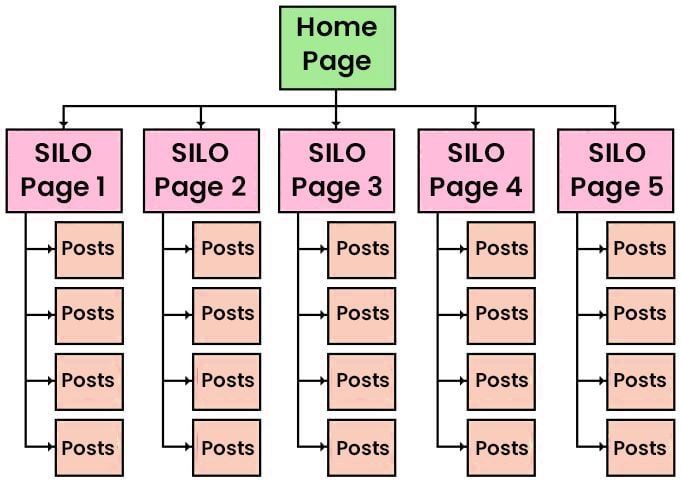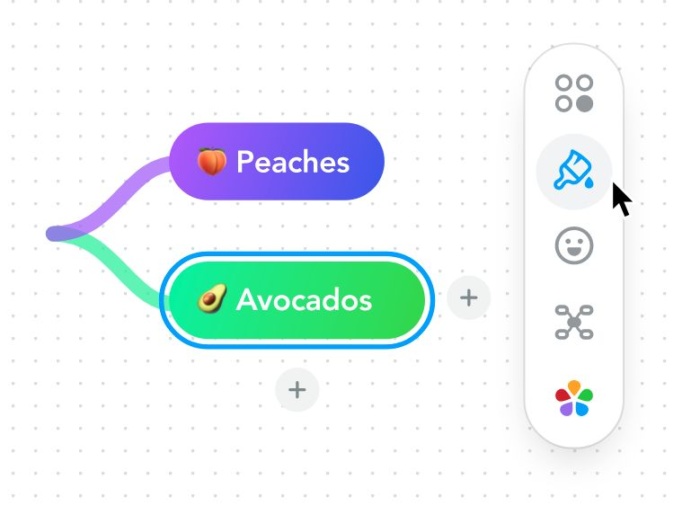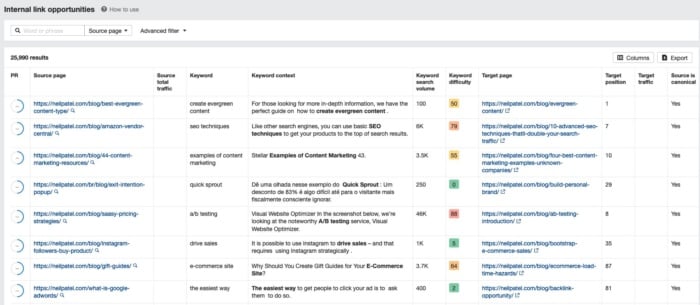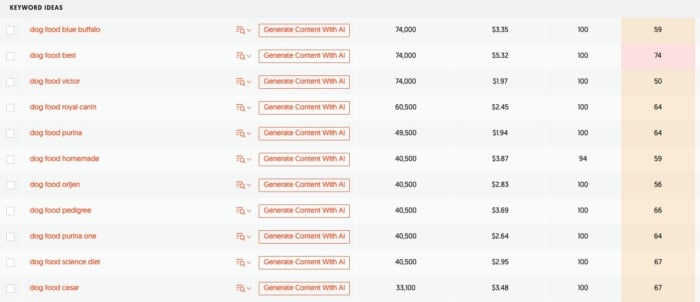
If you’re serious about improving your keyword rankings, then you need to get your site structure on point. Orphan pages and random categories won’t do. Instead, you need a logical way to structure your website around related topics.
That’s why I’m talking about SEO siloing.
SEO siloing is an effective form of website architecture that improves your site’s usability, positions you as an authority, and improves your rankings.
In this article, I’ll explain what SEO siloing is, why it works, how you can start the siloing process, and my best practices for getting it right.
What is SEO Siloing?
SEO siloing isn’t anything like marketing siloing.
Instead, it’s a form of website architecture where you create isolated groups of content about a specific topic:

Each SEO silo has a core homepage that links to a series of related posts, all of which are interlinked. Crucially, there is no interlinking between silos. Each complete silo is isolated from another.
Let’s take my site as an example. You can already see there is a silo structure for SEO in place.

All of my blog articles come under “Blog,” the services provided by my digital marketing agency come under “Services,” and all my internet marketing tools are under the “Tools” heading.
I could take things even further if I wanted to silo my blog content. For example, I could create an SEO silo, a social media marketing silo, and a paid marketing silo. It would be pretty easy for me to segregate my content into these buckets and interlink between them accordingly.
Soft vs. Hard Silos
You can create two types of SEO silos: hard silos and soft silos.
A hard silo is where you form silos using your website’s URL structure. They are a common e-commerce SEO silo strategy, and are also used on websites that sell digital products or provide in-depth reviews.
Here’s an example from The Points Guy:

All of the pages for each credit card provider are nested under the Credit Cards silo. So you get URLs like the following:

Hard silos create physical folders that host each relevant page. They make it very clear to search bots how pages relate to each other. But URLs can get unwieldy, especially if you have very long silo and sub-page names.
A soft silo is where the silo is created only through internal links. Each page has an unnested URL, usually something like:
www.domain.com/page-name
This makes the structure of your site less clear to search engine bots, but it makes the URLs look much better.
How Siloing Benefits SEO
There’s a reason everyone is talking about SEO silos; they’re extremely effective. Here are some of the benefits you can expect from implementing them.
SEO Siloing Promotes Internal Linking
Internal links that connect relevant posts are a core feature of SEO siloing. These links make it much easier for Google to crawl your site, understand your content, and recognize your authority about a given topic.
SEO Siloing Boosts Rankings
Lots of internal links don’t just help Google crawl your site; they can also improve your rankings.
As you probably already know, Google uses the PageRank algorithm to measure the importance of your site’s pages based on the quantity and quality of links pointing to each page—the more authoritative sites that link to you, the higher your PageRank score.
But PageRank scores aren’t just confined to the page that gets the links. Page juice also gets shared across your website via internal links. Therefore, the more internal links your site has—and when you create SEO silos, you should have a lot—the easier PageRank flows between each page, and the higher each page should rank as a result.
SEO Siloing Improves User Experience
SEO Siloed sites tend to be easy to navigate. Users can find related content in a single location and easily move from page to page, thanks to the number of internal links. This significantly improves the user experience and means users spend more time on your website and visit more pages.
Guess what? That also boosts your rankings. Google uses user experience metrics like dwell time and bounce rate to rank websites. So, the more time users spend browsing your site, the better you should rank.
Silos Make it Easier to Add More Keywords in the Future
When you create SEO silos, keyword research becomes a heck of a lot easier. For starters, it’s easy to see which topics you have already written about.
You can then use the main silo topic as a seed keyword for research purposes to identify other relevant topics you haven’t yet covered.
Silos also avoid keyword cannibalization. When you have such a clear structure, it’s easy to pinpoint two pages targeting the same keyword.
The SEO Siloing Process
Are you convinced of the benefits of SEO silos? Ready to get started creating your own? Then follow my step-by-step advice below.
Plan Out Your SEO Silos
Before doing anything else, you must determine your website’s silos. For some of you, this will be easy. You may even have rough silos created using Categories or Tags in WordPress.
Take The Spruce Pets, for example.

They have silos dedicated to each type of pet they write about. Some silos focus on a single pet (cats, dogs, etc.). Others focus on types of pets (reptiles, small pets, etc.).
In other cases, you may need to think carefully about your website’s theme and relevant subcategories.
A topical cluster mind map can be a huge help in this case. A mind map is a great way to visualize your site structure and move existing pages between different silos until you find the perfect fit.
If you’re a visual person, a tool like MindMeister is essential:

If you’re more analytical, then you may prefer a tool like Dynalist. In either case, don’t go any further until you have well-defined silos.
Create a Page to Act As your Silo Hub
Just like the hub and spoke approach to website architecture, SEO siloing requires you to create a home page for each silo.
Here’s an example of a silo hub from The Spruce:

As you can see, these pages don’t have to contain a huge amount of copy. You can create them using links to other related pages on the silo for the most part.
But don’t be afraid to write loads if you want. For instance, Nomadic Matt has an in-depth guide to France that acts as his silo homepage and links off to dozens of France-related articles.

If you want to get your silos set up as quickly as possible, I recommend recreating The Spruce’s silo homepage first and adding links to your relevant sub-pages. You can always add more content to your core page later.
Internally Link Everything
This is arguably the most important part of the SEO siloing process. Internal links turn your silos from an assortment of connected pages to an SEO-boosting machine.
So, create as many relevant internal links as possible. Seriously, every page within an SEO silo should link to at least a couple of other related pages. And the more, the better. Authority Hacker found that the number of relevant internal links highly correlates with search engine rankings.
You can find opportunities for internal links yourself by reading through every article on your site. But I wouldn’t blame you if you found that tedious.
Luckily, there are a couple of tools that can help.
The Ahrefs Webmaster Tool offers a free way to find internal linking opportunities.
Have Ahrefs crawl your site if you aren’t using the tool already, and then click on the “Internal link opportunities” section in the sidebar.
Ahrefs will automatically present hundreds or even thousands of potential internal link opportunities, complete with an anchor keyword, the context of that keyword on the page, and a target page to link to.

Some may not make sense, but a lot will.
Another option is Link Whisper, a premium WordPress plug-in that automatically suggests internal links as you write.

The tool also lets you find pages with very few internal links and provides an internal link report that highlights orphaned pages, broken links, and 404 errors.
Keep Adding Content to Each SEO Silo
Creating your silos is just the start of the process. To maximize the value of SEO silos, you need to keep them updated with fresh content.
I recommend using a keyword research tool to look for keyword or information gaps. Let’s imagine I have a website about dogs, for example.
One of my silos is dog food. So I type that into Ubersuggest, and here’s what I get:

It seems people are looking for information about specific brands of dog food, which means I could create new content reviewing every major brand. I can work through this list in order, ignoring keywords I’ve already written an article for.
You probably don’t need me to tell you to optimize each of these new pages for SEO, but I’m going to do so anyway. Include your target keyword and all variations naturally in the page’s content, subheadings, and title.
Make sure you are adding plenty of internal links to your new content, too — and that you’re only linking to other content in the same silo.
Carrying on the example above, I could write a section in an article targeting “Dog Food Purina” that compares it to Pedigree dog food. This is a great place for a natural internal link. What I wouldn’t do, however, is link it to a page in a different silo about dog toys.
Once you’ve been doing this long enough, you may find that you’ve got multiple pages targeting the same topic and keyword. If that’s the case, don’t be afraid to condense and rewrite content accordingly. Google loves fresh content – I do this on my own site all the time.
Best Practices To Build Effective SEO Silos
Want to take your SEO siloing process to the next level? Follow my best practices:
Make Everything Reachable in Three Clicks
If you want to keep things simple for yourself and your visitors, I highly recommend keeping all your content within three clicks of your home page. This is also known as crawl depth.
This can be hard for older and larger sites, so don’t break your site just to abide by this guideline. But the more pages you have within close distance of your home page, the better.
Think About the User
Improving your site’s SEO is a big benefit of creating silos. But don’t design silos in a way that harms the user experience. For example, you shouldn’t create dozens of different silos. This will make it much harder to move around your site. Instead, try to condense several silos into one or use sub-silos to provide more clarity.
Try to avoid over-optimizing your site’s SEO silos, too. It may not always make sense to use the highest volume keyword as the silo’s name, for instance.
Reinforce Your New Site Structure
The more places you reinforce your new site structure, the clearer it will be for users and search bots.
There are several strategies you can use to reinforce your new siloed structure across your website. These include:
- Adding silos to menus and navigation bars
- Adding breadcrumbs to your website
- Changing your URL structure
Potential Drawbacks of SEO Siloing
The biggest strength of SEO siloing is also, potentially, its biggest weakness. SEO siloing works because you keep each silo completely separate from the others.
But that can inhibit your SEO efforts as you’re not passing on PageRank to other (sometimes related) pages. That’s according to Google’s John Mueller and the team at Ahrefs, who recommend using a top-down or Pyramid structure instead.
If you want to avoid siloing your content completely, you could interlink between different silos where relevant. I’ll leave it up to you to decide whether you’re really creating SEO silos if you take this approach.
SEO Siloing FAQs
Siloing in SEO is a method of organizing and grouping your website’s content into distinct and thematic categories or “silos.” This approach enhances the site’s SEO by making it more user-friendly and helping search engines like Google better understand and index the content.
SEO siloing improves rankings by improving the user experience, crawlability, and authoritativeness of your website. A well-implemented SEO silo strategy structure helps search engines index content, which means you rank for more keywords and increase your topical relevance.
Each silo acts as a thematic unit, making the website’s content more targeted and reducing competition between pages for similar keywords. This structural clarity can result in higher search engine rankings, better user engagement, and improved overall website performance.
Several core components constitute a successful SEO silo structure. These include:
Relevant Content Grouping: Content is strategically grouped into distinct themes or topics, creating individual silos.
Internal Linking: A network of internal links connects pages within the same silo, reinforcing thematic relevance and aiding in navigation.
Clear URL Structure: URLs can be structured to mirror the silo organization, enhancing both user and search engine understanding.
Silo Home Pages: These are central pages for each silo, often optimized for primary keywords and acting as gateways to other pages within the same category.
Keyword Optimization: Pages within each silo are optimized for specific, relevant keywords, improving the chances of ranking higher in search results for those terms.
Siloing is a versatile SEO strategy, but it may not be necessary or beneficial for every website. It is particularly effective for larger websites with diverse content, which can be confusing to browse without silos. For smaller websites with less content, the benefits of siloing might be minimal. I recommend you evaluate your site’s content and structure to determine whether siloing would be beneficial.
Conclusion
Siloing your content can be a powerful way to improve your site’s user experience, make it easier to crawl, and boost your rankings.
Anyone can create a good website structure for SEO, regardless of whether your website is brand new or a dozen years old.
The trick is to create well-defined silos and make internal linking a priority. The more you interlink related pages, the more powerful your silos will be.
Are you using SEO silos on your site? Let me know in the comments.
[ad_2]
Article link
